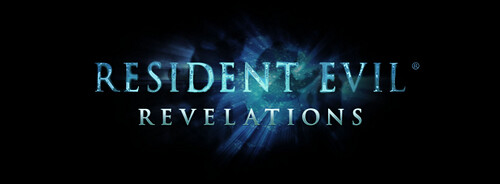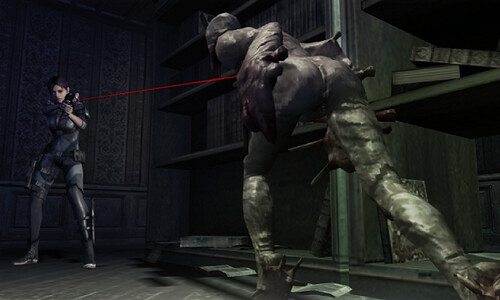|
Disclosure: We may earn a commission from links on this page
|
Developer: Capcom | Publisher: Capcom |
| Release Date: February 7, 2012 | Available On: 3DS |
The Resident Evil series has changed a lot over the years. Gone are the tank-like controls, the confusing backtracking segments, and the punishing inventory limitations that basically defined the first four games in the franchise (including Code: Veronica X). When you think about it, the core experience has evolved a lot since Resident Evil 4 to accommodate the fans of modern shooters, from the over-the-shoulder perspective to the plentiful ammo and health items scattered about each game. Some of the “hardcore” fans of Resident Evil have voiced their disapproval about this issue, but Capcom seems to be moving forward to keep pace with the competition (such as EA’s Dead Space series).

With that in mind, Resident Evil: Revelations is something of a “compromise.” The latest entry in the series is a blend of old and new, ultimately serving as one of the finest “modern” Resident Evil titles and one of the best 3DS games to date. It may still be more “action” than “survival horror,” but Resident Evil: Revelations is nonetheless fantastic, delivering a tense, beefy campaign and a terrific multiplayer component with the addition of Raid Mode. Think no less of it as a handheld game than you would if it were on consoles – Revelations is definitely the next chapter in the franchise, and serves as an important part of the story leading up to Resident Evil 6.
Have a Jill Sandwich
The events in Resident Evil: Revelations take place in 2005 (more specifically, between Resident Evil 4 and 5). The game opens up with BSAA agents Jill Valentine and Parker Luciani being sent on a search-and-rescue mission as they try to locate fellow agents Chris Redfield and Jessica Sherawat. The pair lost contact with HQ and went missing somewhere in the Mediterranean, so Jill and Parker board a tugboat and head toward the luxurious SS Queen Zenobia, a cruise ship that happens to be abandoned and floating ominously in the Mediterranean Sea.

Jill and Parker’s story quickly begins to pick up the pace as the protagonists stumble upon creatures that are infected with a vicious new strain of the dreaded T-Virus (called “T-Abyss”). The BSAA agents also encounter various members of the bio-terrorist group “Il Veltro,” ultimately working with the Federal Bioterrorism Commission (FBC) to prevent the T-Abyss virus from being unleashed as a bioweapon upon the world. To provide additional perspective on the plot and certain characters, Resident Evil: Revelations features occasional flashbacks that take place in the floating city of Terragrigia. These brief scenes depict the aftermath of the “Terragrigia Panic,” a disaster that involved bio-terrorist attacks by Il Veltro, and the ensuing damage control carried out by the FBC and BSAA.
Can You Teach a New Zombie Old Tricks?
Playing Resident Evil: Revelations feels almost exactly like playing last summer’s Mercenaries 3D – after all, the game is largely based on the same kind of third-person, over-the-shoulder action that became the standard in the series after it was originally introduced in Resident Evil 4. The basic controls are almost identical to Mercenaries 3D’s, with movement being assigned to the circle pad. The strafe function (hold the left trigger) and the first-person aiming mode (hold the right trigger) help make this a very accessible game for fans of any first- or third-person shooter. Revelations is one of the first games to support the Circle Pad Pro peripheral, but I never actually felt like it was necessary, and had no problem playing the game from start to finish without one.

The pace and general flow of Resident Evil: Revelations is slower and less chaotic than in the other “modern” Resident Evil titles (RE4 and RE5) There are rarely more than two or three enemies on the screen at any given time, making each encounter feel more tense and threatening. Revelations brings back more of the classic puzzle- and problem-solving elements – it even forces you to backtrack every once in a while, though the map on the bottom screen prevents this from becoming an issue. In fact, other than getting lost a few times, I rarely had trouble making progress in each of the 12 single-player “episodes” (split into four chapters), and the occasional distraction from monster-blasting was actually pretty refreshing. There were only a few areas of the game that seemed to cause me any problems, one being the section with various cranks/valves and jets of steam blocking the way.
Moving on, Revelations’ inventory management is the most hassle-free of any game in the series, largely because it doesn’t exist. The inventory (effectively assigned to the touch screen) is simplified to the point that you never really need to worry about it. Generally speaking, Resident Evil: Revelations is the most accessible, streamlined game in the history of the series. In other words, it is much easier to play (and complete) than its predecessors. Some of the fundamentals of the classics have changed to the point that the “survival-horror” origins of the series have all but vanished from the design. Rarely are your “survival skills” put to the test – at any point in the game, you can carry up to three fully-loaded weapons, a fully supply of three or four different grenades, a melee weapon (knife, machete, etc.), and up to six green herbs. This is all in addition to the new “Genesis” device, which is used to scan the environment for hidden items, and to collect “enemy data” (which ultimately rewards you with more green herbs).

Here’s the “problem”: there is little pressure to regulate your inventory, whether you are picking up random stuff or leaving behind extra ammo. On Casual difficulty, the supplies are almost too plentiful. If you have any skill at all, there is little reason to worry about taking damage or preserving ammo; the only major threats are the monsters with one-hit-kill attacks. Normal Mode tightens things up with stricter distribution of ammo drops and green herbs; regardless, Revelations ends up feeling more like an action title than its survival-based predecessors. There were only a few parts throughout the campaign that I had to watch my ammo or run like hell to avoid dying; just by exploring the environment, looting each room, and using the Genesis scanner, I had no problem stockpiling green herbs and bullets of any kind. This will really only be a problem for the old-school Resident Evil fans who are still reluctant to embrace the modern-style games in the franchise, but even I was a little bummed that there was no form of RE4’s inventory management to let my OCD run wild.
Revelations might feel more like an “action” game than the first three or four Resident Evil titles, but the settings (the rooms, corridors, and deck of the SS Queen Zenobia) and the level designs (cramped interiors, narrow hallways, twisted paths leading to dead ends, etc.) are actually very reminiscent of the classic games. As I said before, you typically encounter one or two “BOWs” at a time, and almost never more than four or five. Rarely are you swarmed or surrounded on all sides by your enemies; this was the idea that actually played a fundamental part in RE4 and RE5’s design, making them feel tense, claustrophobic, and chaotic. While the player may have been bombarded and swallowed up by hordes of undead, there was plenty of real estate to work with. In this case, Revelations feels a lot more like the Gamecube prequel Resident Evil 0 in that it forces you to deal with your foes in a cramped, cluttered, and claustrophobic environment.
Rule #8: Get a Kick Ass Partner (For Raid Mode)
As much as I have already said about the game design, the production values and CG scenes, and the story mode, Revelations’ Raid Mode is my favorite part of the entire package. Raid Mode supports solo play, but was clearly designed for local or online co-op. Ultimately this bonus mode feels like the game that last year’s Mercenaries 3D could have been, if it wasn’t essentially Capcom’s test-run for the Revelations design team.
Raid Mode offers 50 different stages, with each map being lifted from a particular section of the story mode. Each stage is progressively harder than the last, filled to the brim with the various enemies seen in single-player – even the occasional boss character. The stages are also sprinkled with power-ups, ammo, and bonus custom parts for your weapons.

As you kill the enemies, survive the stages, and complete the various “Missions” (these are similar to Call of Duty’s “Challenges”), you earn experience points, level up, and stockpile Battle Points. Naturally, leveling up makes your Raid Mode character stronger, but it also allows you to equip better versions of the weapons – higher-leveled clones with more custom part slots, stronger bullets, higher capacity, etc. The Battle Points can also be used between each session in the Raid Mode Store to purchase additional weapons, custom parts, ammo bags, and supplies.
In addition to all this, Raid Mode utilizes the 3DS’s StreetPass/SpotPass functions to extend the replay value even further: if you happen to cross by another Revelations owner, you will unlock a new Mission in Raid Mode that has you hunting down your buddy and shooting him in the face in order to collect special rewards. I would have liked to trade custom parts somehow – perhaps even weapons in general – but for what it is, Raid Mode is excellent.
See No Evil, Hear No Evil
Before I wrap up my review, I would like to point out perhaps the most impressive fact about Resident Evil: Revelations – at no point in my experience did I feel like the game was limited by its status as a handheld game. This is undoubtedly the 3DS’s crowning achievement in terms of production values, from the graphics to the music. In fact, some of the CG scenes look better than what you see in many console titles. Even the in-game graphics are the best on the handheld to date, showing nearly the same level of detail seen in Resident Evil 5, without any major frame rate issues. The clarity is simply amazing; overall the 3DS does a fantastic job of bringing the full Resident Evil experience to life on a handheld system. This isn’t limited to visuals; the soundtrack is fantastic, and the occasionally-cheesy voice acting stays true to Resident Evil traditions. Finally, I would like to point out that the sound effects blast out of the 3DS’s speakers, and the surround sound effect is actually achieved very well. Since this is a key part of building atmosphere, it makes Revelations that much more impressive to see and to hear.
Resident Evil fans without a 3DS might want to consider picking one up for Revelations; most of the “flaws” I pointed out in this review are more a matter of preference than actual setbacks. In fact, Revelations has few flaws at all – for a 3DS title, it looks fantastic and sets the bar for bringing console-quality experiences to the handheld. The in-game 3D effect is a natural fit for the first-person aiming mechanics and the claustrophobic level design – but it is even more brilliant in the amazing CG scenes. As a Resident Evil title, the controls feel very intuitive, even without the Circle Pad Pro attachment – from strafing and aiming in first-person to switching between weapons and managing your inventory on the touch screen.
Revelations is not only one of the best 3DS games to date (personally, I’d put it just behind Super Mario 3D Land and Mario Kart 7); I think it ranks among the best in a franchise known for its excellence.
| Graphics: | 9.5 |
| Sound: | 9.5 |
| Gameplay: | 9 |
| Creativity: | 8 |
| Replay Value/Game Length: | 8.5 |
| Final: | 9.2 out of 10 |
| Written by Cliff Bakehorn | Write a User Review |